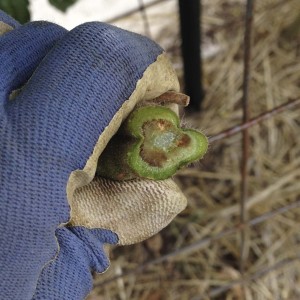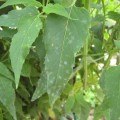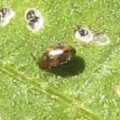Fusarium is a soil-borne fungus that can survive for a decade or more in dormant stages. It enters the plant through roots and invades its water distribution network, where the fungi partially or completely block the vascular tissues, usually by gum-like formations, causing wilting and eventually death of the plant.
General Description
- Widespread fungus that affects a wide range of crops
- Each species of Fusarium attacks a particular crop
- For more information and treatment of fungal diseases in general, see “Fungal Diseases“
- Fusarium is most common in heavy or wet soils but can be in any soil, even in seed trays
- usually introduced by planting infected seedlings or plants but may also be present in the soil
- VGPS-210: The fungi attack and destroy plant roots and then spread into the plant’s vascular system near the crown, blocking the flow of water from roots to stems and leaves
- may persist in plant debris and may also be capable of remaining viable in the soil for several years (some sources say 20+ years)
Species & Taxonomy
- Kingdom:
- Phylum:
- Class:
- Order:
- Family:
- Genus Species: Fusarium spp.
- most commonly caused by Fusarium oxysporum
Other Diseases Caused by Fusarium Species
- Aster Wilt
- Cabbage Yellows
- Foot & Root Rot (or Basal Rot)
- Gladiolus Corm Rot
- Narcissus Basal Rot
- Snow Mold
- Turf Drought
Plants Affected by Fusarium Wilt
- cabbage
- Most vegetable crops
- Beans
- carnations
- Eggplant
- Okra
- Passionfruits (may be serious in some subtropical areas)
- Peas
- Pepper
- Potato
- Sweet Peas (Lathyrus odoratus)
- Tomato (Fusarium oxysporum f. sp. lycopersici)
Plants Unaffected
- cauliflower
- broccoli
- brussels sprouts
Signs & Symptoms
The first symptom of Fusarium often is wilting of the foliage on one side of the plant
Whole Plant
- In cabbage: entire plant may yellow, wilt, and collapse
- soft-stemmed plants wilt, either in part or entirely
- woodier-stemmed plants may retain their overall shape, but foliage on affected stems wilts and withers
- internal staining of the vascular tissue may occur and is usually brown or black
- death almost always follows, either rapidly or over several seasons, depending on the plant affected
- cool, damp conditions may encourage very pale pink or white, slightly fluffy fungal growth from the infected tissues
Leaves
- In cabbage: lower leaves yellow (often on just one side of the plant) later turning brown and fall off; if you cut the stem, a brown discoloration of the water-conducting tissues can be seen
- woodier-stemmed plants may retain their overall shape, but foliage on affected stems wilts and withers
- symptoms are very similar to those caused by drought; dry soil may encourage rapid wilt symptoms, but they do not recover permanently when watered
- symptoms are also very similar to Squash Bug infection, but gray or brown insects will be present, typically in the interior of the plant, under leaves, and on fruit
- fungal infection of vascular tissues; very similar to verticillium wilt; leaves and stems turn yellowish. Plants wilt and have a brown discoloration inside the stems. Plant growth is stunted and yields are reduced
- TWM-63: this is the first thing to suspect when tomato leaves start to yellow from the bottom of the plant up.
- AHSEG-646: Black patches develop on stems and foliage; they are sometimes covered with a white or pale pink fungal growth.
- AHSEG-653: if cut longitudinally in the early stages of degeneration they may show a central, vascular column of brown discoloration
- VGPS-210: occurs in hot weather, and plants often show no symptoms until they are close to maturity. Verticillium wilt, which causes similar symptoms, tends to occur in cool, wet weather, such as late spring. Lower leaves wilt. Frequently all leaves on one side of the plant will wilt. Yellow patches may show up on leaves; leaves may die. Beet & Swiss chard leaves will curl inward; potato and tomato leaves curl under. Dark lesions appear on lower stems in half lengthwise to reveal reddish brown or black streaks inside. On vining crops such as sweet potatoes and squash, the first symptom often is yellowing and wilting of the older leaves. Other times, vines wilt without showing any other symptoms first. Vines may be stunted or die completely.
Flowers
- in carnations (dianthus), the flowers fade prematurely and the leaves wilt and discolor
Fruit
Roots
- Roots turn black and die
How to Positively Identify
When cutting off diseased branches or stems, cut the stem at an angle. If the disease is present, there will be a dark layer in the vascular parts of the cross-section.
Treatment
- remove infected plants promptly
- remove soil or soil mix from the immediate vicinity of the roots
- do not grow the same or closely related plants on the site again, or at least a minimum of 5 years
- BBGS-115: crop rotation is important, as well as the planting of resistant varieties where available. Practice a 4-year rotation plan for okra
- AHSEG-646: There is no cure for affected plants. Remove them and the soil in their vicinity, and destroy the plants. Avoid growing susceptible plants in the area. Propagate only from healthy stock; if possible, grow resistant cultivars
- VGPS-211: no treatment, but if the plants are near maturity, harvest what you can before uprooting the infected crop debris. If the plants are young and symptoms are mild, you can try to nurse the crop through by watering regularly. Otherwise, remove infested crop residues from the garden, taking care not to spread the debris while you work. Discard or destroy this debris; if you compost it, be sure not to apply that compost in your vegetable garden or you’ll end up spreading the fungi throughout your garden. It’s okay to apply the compost to ornamentals because Fusarium fungi are so host-specific. Solarizing infected beds during the hottest part of the summer will help to reduce the levels of Fusarium fungi.
Prevention & Control
Avoid introducing the pathogen to clean fields, since it survives indefinitely in the soil.
Cultural Controls:
Habitat:
- next time you plant, adjust soil pH to 6.5 to 7.0 several weeks before plantingMulch to keep sol cool and moist, and add compost to boost beneficial soil microorganisms.
- BBGS-114: fungus lives in the soil and infects plants through the roots; fungus develops in hot dry weather
Temperature & Humidity:
- For cabbage: plant in spring or winter, as this fungus develops most rapidly at temperatures ranging from 75° to 85° F.
- VGPS-210: occurs in hot weather, and plants often show no symptoms until they are close to maturity. Verticillium wilt, which causes similar symptoms, tends to occur in cool, wet weather, such as late spring
Mulching & Cultivation Practices:
- Plant resistant cultivars
- Planting resistant and tolerant varieties is the best defense when you know that your soil contains Fusarium fungi
- be sure to buy certified disease-free seed potatoes.
- Always handle plants carefully to avoid creating wounds.
- Crop Rotation: Fusarium spores can persist so long in soil — up to 15 years — that you can’t rid your garden of Fusarium by rotating crops. However, since each crop family or individual crop is attacked by a different species of Fusarium, practicing crop rotation will help to prevent a continual buildup of Fusarium fungi in your garden. Plan a 4-year rotation (or longer) if possible.
- damage creating open wounds when spores are in the vicinity can make plant more susceptible
- non-sterile pruning shears or other tools transmit it to healthy plants, so make sure to clean & sterilize your tools
- infected root material is also a way to transfer it to other plants, so make sure to clean up after removing infected plants
- AHSEG-646: Various species of the microscopic fungus Fusarium, which are present in the soil or on plant debris, or are sometimes seedborne; they may also be introduced on new stock. They will build up in the soil when the same type of plant is grown in the same site year after year.
Natural Enemies & Biological Controls
Insects:
Animals:
Reptiles:
Barriers
Traps
Sprays & Dusts
Sources:
- VGPS
- AHSEG
- BBGS
- TWM





Hello,
How does one go about finding resistant cultivars? I am having difficulty locating seeds that state cultivars will be resistant to fusarium (does this exist?) and how do I look?
Any help much appreciated!
Thanks!
Hello!
Disease resistance will be shown in the plant description. There is an abbreviation system for most plant diseases, so you’ll see a list of capital letters in the description where it lists the different diseases that a cultivar has resistance.
Here’s an example: https://territorialseed.com/collections/tomato/products/tomato-bobcat?variant=12786157944931
At the end of the paragraph describing the tomato, you see “F 1–2, L, V.” This means that the cultivar has resistance to Fusarium races 1 and 2 (F 1-2), as well as Gray Leaf Spot (L), and Verticillium Wilt (V).
The F1 shown elsewhere on the page means that it’s an F1 hybrid, and this type of notation is easy to confuse with a disease reference.
By the way, I have not grown this cultivar, so I’m not recommending it – I just found it as an example of how to determine disease resistance. 🙂
I have found that the cultivars that are resistant to Fusarium are usually hybrids, and I really like the variety of heirloom and open-pollinated tomatoes better, so I’m back to trying to manage with non-resistant varieties.
Grafting is one way that I’ve been successful, but now I can no longer find the rootstock that does well in my growing conditions. = back to square 1…
The newest approach that I have been trying out is with soil biology. I’m trying out a fungal inoculant that is supposed to parasitize the Fusarium fungi in the soil, and prevent the tomatoes from getting it.
If you want to go that route, here’s the product I’m trying: https://amzn.to/31Kh5pe
Good luck!
-Lisa